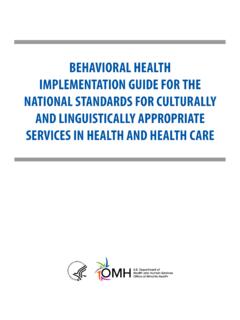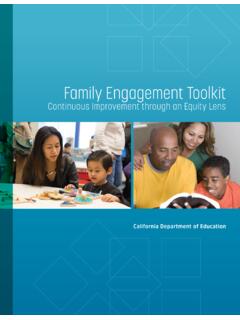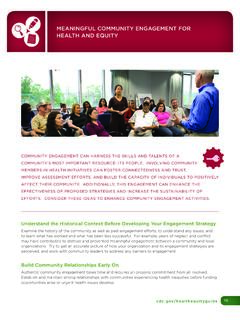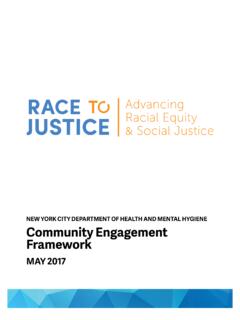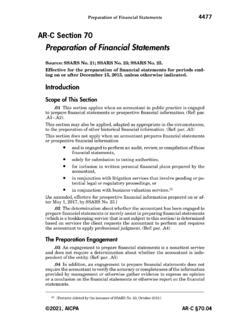Transcription of Evaluation of the National CLAS Standards
1 Evaluation of the National CLAS StandardsTips and ResourcesMalcolm V. Williams, Laurie T. Martin, Lois M. Davis, Linnea Warren May, and Alice KimPR-3599-DHHS/OMHPREFACE SUMMARY CHAPTER 1 About the Toolkit Importance of Evaluating the National CLAS Standards What This Toolkit Is Designed to Do Who Should Use This Toolkit? How the Toolkit Is Organized CHAPTER 2 Getting Started STEP 1: Assess Organizational and Community Needs STEP 2: Set Goals and Objectives STEP 3: Develop a Logic Model STEP 4: Identify Evaluation Research Questions STEP 5: Choose Measures STEP 6: Design Evaluation and Collect Data STEP 7: Share Findings and Make Changes as Part of CQI CHAPTER 3 Tips for Evaluating the National CLAS Standards PRINCIPAL STANDARD: Standard 1 GOVERNANCE, LEADERSHIP, AND WORKFORCE: Standards 2 4 COMMUNICATION AND LANGUAGE ASSISTANCE: Standards 5 8 engagement , CONTINUOUS IMPROVEMENT, AND ACCOUNTABILITY.
2 Standards 9 15 CHAPTER 4 Evaluation Resources APPENDIX A Ambulatory Care Setting APPENDIX B Behavioral Health Setting APPENDIX C Hospital Setting APPENDIX D Public Health Setting APPENDIX E Cross-Cutting Measures REFERENCES Preface The Department of Health and Human Services (HHS) Office of Minority Health (OMH) developed the National Standards for Culturally and Linguistically Appropriate Services in Health and Health Care ( National CLAS Standards ) to provide meaningful and practical guidance on delivering culturally and linguistically appropriate services. The National CLAS Standards , which are targeted toward health and health care organizations, were revised in 2013 to account for the increasing diversity of the population, the growth in cultural and linguistic competency fields, and the changing landscape with respect to new National policies and legislation, including the Affordable Care Act.
3 The organizations that are adopting and implementing the National CLAS Standards have taken concrete steps to address health inequities and meet the needs of the vulnerable populations they serve. However, what is less clear is the extent to which these organizations are evaluating the impact of their approach to improve inequities in care. To help address these questions, OMH commissioned the development of a framework and toolkit to guide efforts to evaluate the National CLAS Standards across four settings: ambulatory care, behavioral health, hospitals, and public health. This work was sponsored by the Department of Health and Human Services, Office of Minority Health under contract No. HHSP233201500038I. The research was conducted in RAND Health, a division of the RAND Corporation. A profile of RAND Health, abstracts of its publications, and ordering information can be found at The RAND Corporation is a research organization that develops solutions to public policy challenges to help make communities throughout the world safer and more secure, healthier and more prosperous.
4 RAND is nonprofit, nonpartisan, and committed to the public interest. Copyright 2018 RAND Corporation 2 PREFACE SUMMARY CHAPTER 1 About the Toolkit Importance of Evaluating the National CLAS Standards What This Toolkit Is Designed to Do Who Should Use This Toolkit? How the Toolkit Is Organized CHAPTER 2 Getting Started STEP 1: Assess Organizational and Community Needs STEP 2: Set Goals and Objectives STEP 3: Develop a Logic Model STEP 4: Identify Evaluation Research Questions STEP 5: Choose Measures STEP 6: Design Evaluation and Collect Data STEP 7: Share Findings and Make Changes as Part of CQI CHAPTER 3 Tips for Evaluating the National CLAS Standards PRINCIPAL STANDARD: Standard 1 GOVERNANCE, LEADERSHIP, AND WORKFORCE: Standards 2 4 COMMUNICATION AND LANGUAGE ASSISTANCE: Standards 5 8 engagement , CONTINUOUS IMPROVEMENT, AND ACCOUNTABILITY: Standards 9 15 CHAPTER 4 Evaluation Resources APPENDIX A Ambulatory Care Setting APPENDIX B Behavioral Health Setting APPENDIX C Hospital Setting APPENDIX D Public Health Setting APPENDIX E Cross-Cutting Measures REFERENCES Summary Among the many contributors to health inequities, the lack of culturally and linguistically ap propriate services in health settings has been recognized as one of the more modifiable factors.
5 Improving the availability of such services will not only improve the quality of care provided, but may reduce disparities experienced by racial and ethnic minorities and other underserved popu lations, who struggle because of language, literacy, or other cultural barriers (Saha, Beach, and Cooper, 2008). To provide meaningful and practical guidance on delivering culturally and lin guistically appropriate services, the Department of Health and Human Services (HHS) Office of Minority Health (OMH) developed the National Standards for Culturally and Linguistically Appropriate Services in Health and Health Care ( National CLAS Standards ). The National CLAS Standards , which are targeted toward health and health care organizations (HCOs), were revised in 2013 to account for the increasing diversity of the population, the growth in cultural and linguistic competency fields, and the changing landscape with respect to new National policies and legislation, including the Affordable Care Act (ACA) (HHS OMH, 2013).
6 Successful implementation of the National CLAS Standards requires an organizational commitment. Undoubtedly, the National CLAS Standards have helped to increase awareness and activities related to the need for culturally and linguistically appropriate services. The organizations that are adopting and implementing the National CLAS Standards have taken concrete steps to address health inequities and meet the needs of the vulnerable populations they serve. However, what is less clear is the extent to which these organizations are evaluating the impact of their approach to improve inequities in care. 3 SUMMARY PREFACE SUMMARY CHAPTER 1 About the Toolkit Importance of Evaluating the National CLAS Standards What This Toolkit Is Designed to Do Who Should Use This Toolkit? How the Toolkit Is Organized CHAPTER 2 Getting Started STEP 1: Assess Organizational and Community Needs STEP 2: Set Goals and Objectives STEP 3: Develop a Logic Model STEP 4: Identify Evaluation Research Questions STEP 5: Choose Measures STEP 6: Design Evaluation and Collect Data STEP 7: Share Findings and Make Changes as Part of CQI CHAPTER 3 Tips for Evaluating the National CLAS Standards PRINCIPAL STANDARD: Standard 1 GOVERNANCE, LEADERSHIP, AND WORKFORCE: Standards 2 4 COMMUNICATION AND LANGUAGE ASSISTANCE: Standards 5 8 engagement , CONTINUOUS IMPROVEMENT, AND ACCOUNTABILITY.
7 Standards 9 15 CHAPTER 4 Evaluation Resources APPENDIX A Ambulatory Care Setting APPENDIX B Behavioral Health Setting APPENDIX C Hospital Setting APPENDIX D Public Health Setting APPENDIX E Cross-Cutting Measures REFERENCES To help address these questions, OMH awarded a contract to RAND to develop a framework and toolkit to guide efforts in evaluating the implementation of the National CLAS Standards by HCOs. The resulting report, Development of a Long-Term Evaluation Framework for the National Standards for Culturally and Linguistically Appropriate Services (CLAS) in Health and Health Care, presents the details of the development of the framework (Davis et al., forthcoming), while this accompanying toolkit distills the elements of the framework and is intended to help guide the efforts of HCOs to evaluate the implementation of the National CLAS Standards across four settings: ambulatory care, behavioral health, hospitals, and public health.
8 This toolkit is thus divided into four sections: CHAPTER ONE provides information about the toolkit, who should use it, and what it is designed to help you do. CHAPTER TWO describes seven steps for implementing and evaluating the National CLAS Standards . CHAPTER THREE provides additional context and details for evaluating specific National CLAS Standards . CHAPTER FOUR includes relevant resources and information on potential data sources and metrics that may be used in your Evaluation . 4 PREFACE SUMMARY CHAPTER 1 About the Toolkit Importance of Evaluating the National CLAS Standards What This Toolkit Is Designed to Do Who Should Use This Toolkit? How the Toolkit Is Organized CHAPTER 2 Getting Started STEP 1: Assess Organizational and Community Needs STEP 2: Set Goals and Objectives STEP 3: Develop a Logic Model STEP 4: Identify Evaluation Research Questions STEP 5: Choose Measures STEP 6: Design Evaluation and Collect Data STEP 7: Share Findings and Make Changes as Part of CQI CHAPTER 3 Tips for Evaluating the National CLAS Standards PRINCIPAL STANDARD: Standard 1 GOVERNANCE, LEADERSHIP, AND WORKFORCE: Standards 2 4 COMMUNICATION AND LANGUAGE ASSISTANCE: Standards 5 8 engagement , CONTINUOUS IMPROVEMENT, AND ACCOUNTABILITY.
9 Standards 9 15 CHAPTER 4 Evaluation Resources APPENDIX A Ambulatory Care Setting APPENDIX B Behavioral Health Setting APPENDIX C Hospital Setting APPENDIX D Public Health Setting APPENDIX E Cross-Cutting Measures REFERENCES SUMMARY The National CLAS Standards The National CLAS Standards were intended to advance health equity , improve quality, and help eliminate health care disparities by providing a blueprint for individuals and HCOs to implement culturally and linguistically appropriate services. The essential goal of the National CLAS Standards is framed in the Principal Standard: Provide effective, equitable, understandable, and respectful quality care and services that are responsive to diverse cultural health beliefs and practices, preferred languages, health literacy, and other communication needs. The remaining 14 Standards span the themes of governance, leadership, and workforce; communication and language assistance; and engagement , continuous improvement, and accountability (HHS OMH, 2013).
10 GOVERNANCE, LEADERSHIP, AND WORKFORCE 1. Advance and sustain organizational governance and leadership that promotes CLAS and healthequity through policy, practices, and allocated Recruit, promote, and support a culturally and linguistically diverse governance, leadership, andworkforce that are responsive to the populations in the service Educate and train governance, leadership, and workforce in culturally and linguistically appropriatepolicies and practices on an ongoing AND LANGUAGE ASSISTANCE 4. Offer language assistance to individuals who have limited English proficiency and/or othercommunication needs, at no cost to them, to facilitate timely access to all health care and Inform all individuals of the availability of language assistance services clearly and in their preferredlanguage, verbally and in Ensure the competence of individuals providing language assistance, recognizing that the use ofuntrained individuals and/or minors as interpreters should be Provide easy-to-understand print and multimedia materials and signage in the languagescommonly used by the populations in the service PREFACE SUMMARY CHAPTER 1 About the Toolkit Importance of Evaluating the National CLAS Standards What This Toolkit Is Designed to Do Who Should Use This Toolkit?
